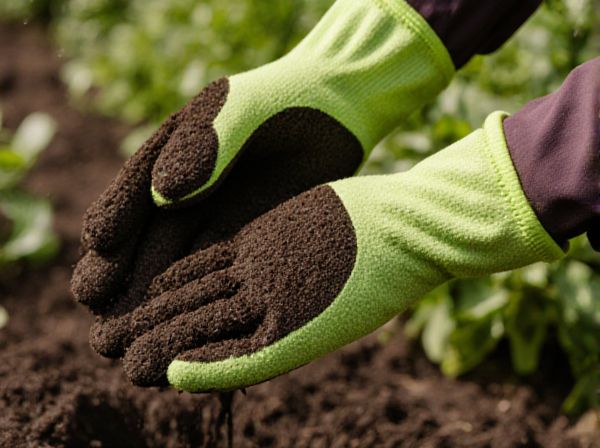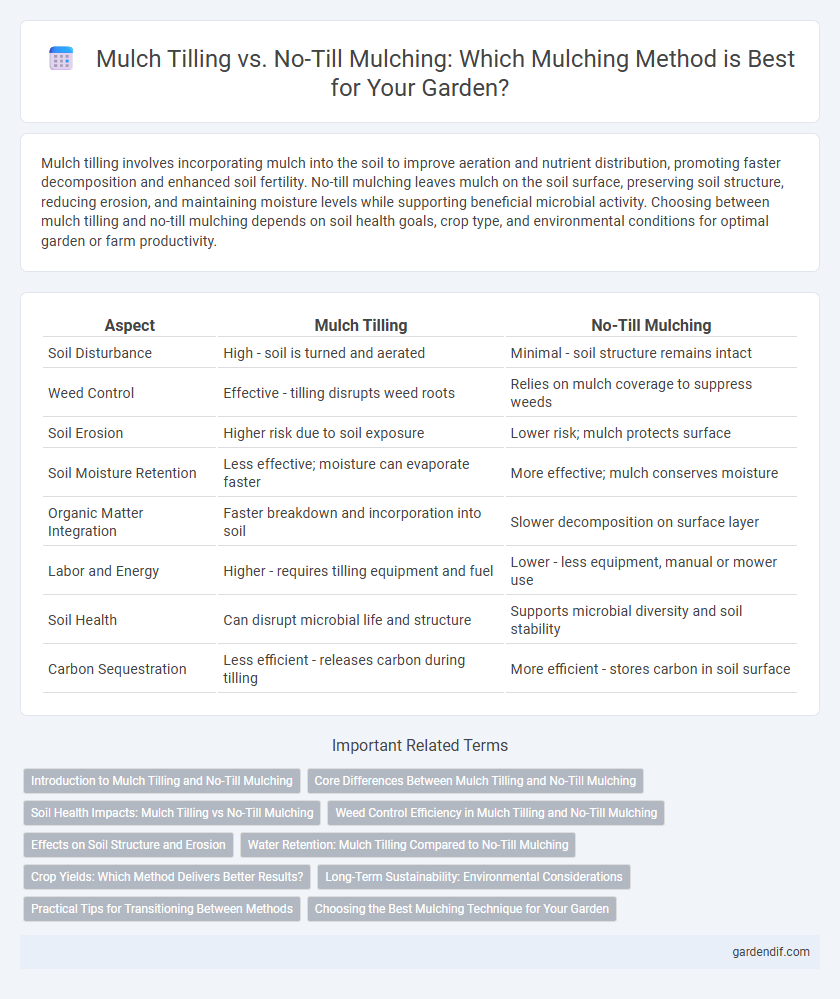
Mulch tilling vs No-till mulching Illustration
Mulch tilling involves incorporating mulch into the soil to improve aeration and nutrient distribution, promoting faster decomposition and enhanced soil fertility. No-till mulching leaves mulch on the soil surface, preserving soil structure, reducing erosion, and maintaining moisture levels while supporting beneficial microbial activity. Choosing between mulch tilling and no-till mulching depends on soil health goals, crop type, and environmental conditions for optimal garden or farm productivity.
Table of Comparison
| Aspect | Mulch Tilling | No-Till Mulching |
|---|---|---|
| Soil Disturbance | High - soil is turned and aerated | Minimal - soil structure remains intact |
| Weed Control | Effective - tilling disrupts weed roots | Relies on mulch coverage to suppress weeds |
| Soil Erosion | Higher risk due to soil exposure | Lower risk; mulch protects surface |
| Soil Moisture Retention | Less effective; moisture can evaporate faster | More effective; mulch conserves moisture |
| Organic Matter Integration | Faster breakdown and incorporation into soil | Slower decomposition on surface layer |
| Labor and Energy | Higher - requires tilling equipment and fuel | Lower - less equipment, manual or mower use |
| Soil Health | Can disrupt microbial life and structure | Supports microbial diversity and soil stability |
| Carbon Sequestration | Less efficient - releases carbon during tilling | More efficient - stores carbon in soil surface |
Introduction to Mulch Tilling and No-Till Mulching
Mulch tilling involves integrating organic material into the soil through mechanical agitation, enhancing aeration and nutrient incorporation for crop growth. No-till mulching preserves soil structure by applying mulch layers directly on the surface, reducing erosion and improving moisture retention. Both methods optimize soil health but differ in their approach to disturbance and long-term soil management.
Core Differences Between Mulch Tilling and No-Till Mulching
Mulch tilling involves turning the soil to incorporate organic mulch, promoting aeration and mixing nutrients directly into the soil, which enhances root penetration and weed control. No-till mulching leaves the soil intact while applying a layer of organic material on the surface, preserving soil structure and moisture, and minimizing erosion and carbon loss. The core difference lies in soil disturbance: mulch tilling actively disrupts soil layers for nutrient integration, whereas no-till mulching maintains soil integrity by reducing mechanical intervention.
Soil Health Impacts: Mulch Tilling vs No-Till Mulching
Mulch tilling disrupts soil structure by breaking up organic matter and exposing microorganisms to air, which can accelerate decomposition but also increase erosion risks. No-till mulching preserves soil integrity, enhances microbial diversity, and maintains moisture levels by leaving plant residues intact. Studies show no-till methods improve long-term soil fertility and carbon sequestration compared to mulch tilling practices.
Weed Control Efficiency in Mulch Tilling and No-Till Mulching
Mulch tilling effectively disrupts weed seed germination by mechanically uprooting existing weeds and incorporating mulch into the soil, enhancing weed control efficiency. No-till mulching suppresses weed growth by forming a protective mulch layer that limits light penetration to weed seeds, reducing their ability to germinate. Studies show mulch tilling can provide faster visible weed reduction, while no-till mulching offers longer-term weed suppression with less soil disturbance.
Effects on Soil Structure and Erosion
Mulch tilling disrupts soil structure by breaking up aggregates, which can increase short-term nutrient availability but may lead to higher erosion risks due to soil exposure and reduced organic matter retention. No-till mulching preserves soil aggregates and microbial activity, enhancing soil porosity and water infiltration while significantly reducing surface erosion by maintaining a protective organic layer. Studies show no-till systems improve long-term soil stability and carbon sequestration compared to conventional tillage with mulch incorporation.
Water Retention: Mulch Tilling Compared to No-Till Mulching
Mulch tilling disrupts soil structure, leading to increased evaporation and reduced water retention compared to no-till mulching, which preserves soil integrity and enhances moisture conservation. No-till mulching maintains organic layers on the soil surface, reducing runoff and promoting deeper water infiltration. Studies indicate no-till mulching can improve soil moisture content by up to 30% over mulch tilling in arid and semi-arid regions.
Crop Yields: Which Method Delivers Better Results?
No-till mulching often enhances crop yields by preserving soil structure, moisture, and organic matter, leading to healthier root development. Mulch tilling can temporarily aerate the soil but may disrupt beneficial microbial communities, potentially reducing long-term fertility. Studies indicate no-till methods consistently deliver better yield stability and improved nutrient retention compared to traditional mulch tilling.
Long-Term Sustainability: Environmental Considerations
Mulch tilling enhances soil aeration and nutrient integration but can disrupt soil structure and microbial communities, potentially leading to erosion and carbon loss over time. No-till mulching preserves soil integrity, promotes biodiversity, and enhances carbon sequestration, making it a more sustainable option for long-term environmental health. Studies highlight no-till practices as critical for reducing greenhouse gas emissions and improving water retention in agricultural ecosystems.
Practical Tips for Transitioning Between Methods
Transitioning from mulch tilling to no-till mulching requires careful soil preparation to maintain nutrient balance and prevent compaction. Incorporate organic matter such as compost or cover crops to enhance soil structure and support microbial activity. Adjust mulch thickness to 3-4 inches to protect soil moisture and suppress weeds effectively without disturbing the soil ecosystem.
Choosing the Best Mulching Technique for Your Garden
Mulch tilling aerates the soil and incorporates organic matter, promoting nutrient availability and improving root growth, ideal for gardens needing soil rejuvenation. No-till mulching preserves soil structure, enhances moisture retention, and reduces erosion, making it suitable for sustainable gardening with minimal disturbance. Assess your garden's soil health, crop type, and long-term goals to choose the best mulching technique that maximizes plant productivity and soil conservation.
Mulch tilling vs No-till mulching Infographic

 gardendif.com
gardendif.com